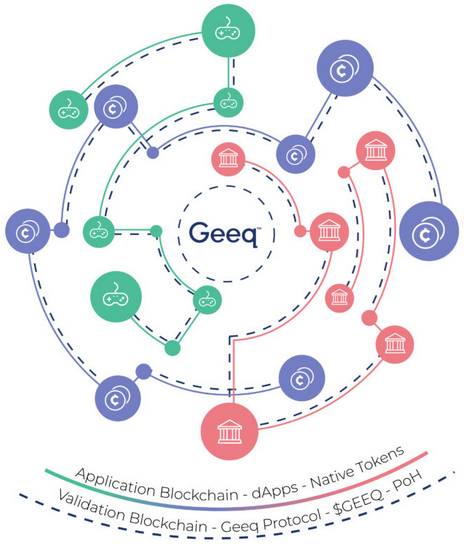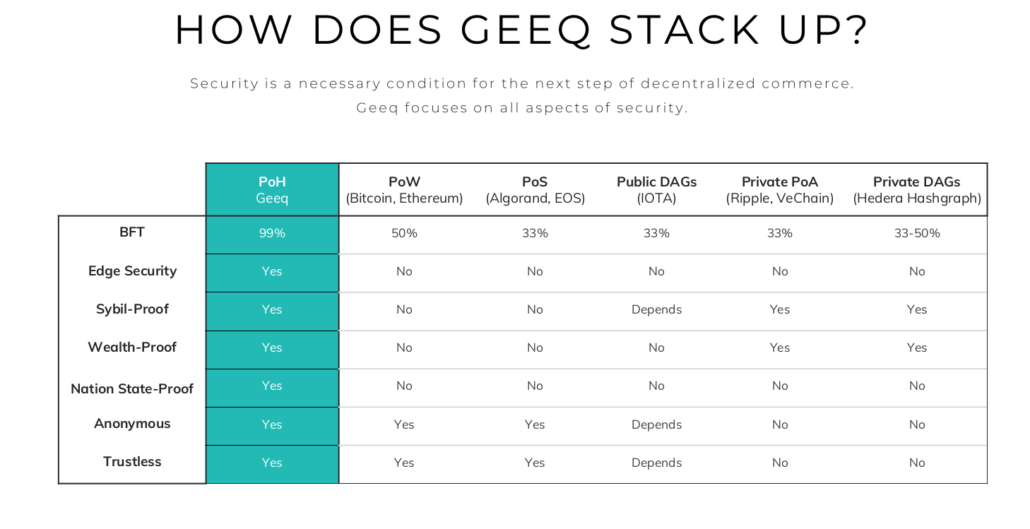By: Geeq on Oct 10, 2019
Proof-of-Honesty (PoH) is the proprietary protocol that sets Geeq™ apart from the existing field of blockchain platforms. Many ambitious projects that were deployed on early blockchain platforms have failed to achieve mass adoption. The reason for this is due to the shortcomings in Proof-of-Work (PoW) and Proof-of-Stake (PoS) based systems, which limit the amount these platforms can be trusted, scale, and remain cost-efficient. Geeq™ and PoH will provide future blockchain projects with the infrastructure and platform to truly deploy their vision and achieve their goals. Resulting in more projects making a positive impact, driving us towards mass usage of products and services that are based on blockchain, the future of many industries.
This article will look to explain PoH, how it is a more secure and scalable solution to existing blockchain protocols, and why it will make an impact in your day-to-day tech lives.
Here is the Simple Description of a Blockchain
Before diving into explaining a blockchain protocol, we feel it’s a good idea to revisit what precisely a blockchain is. Even if you feel you already know, it’s always great to go over the details as we’re going to be referring to a couple of the main features of a blockchain in order to allow you to grip how Proof of Honesty unlocks its potential.
At their core, blockchains are simply online/electronic records that group ‘transactions’ together in blocks. (Transactions can be in the shape of things such as data, money, or online digital assets).
These blocks are connected in a time-based sequence which gives the appearance of a chain. Hence why they are called blockchains. (Which is far more catchy than ‘sequentially ordered electronic ledgers’ in our book).
Here’s An Example
Blockchains work a little bit like conventional databases, in the sense that they keep a record of all the comings and goings which occur through that database’s network.

As an example, your home insurance provider will have a record of all your personal details, what items you have in your home, and your occupation, as well as your insurance history. They’ll capture this data by you providing, and signing it off, in order to verify it is accurate.
Your insurance provider will then store this data themselves on their drives using their computing power to manage it. In other words, they have the ability to alter or delete records as they see fit, meaning the data they store is only as reliable as the people that input, protect and store it.
If you need to make a ‘transaction’ with your insurance provider, i.e. make a claim, you inform them that there’s been an accident, theft, damage to your property and they gather the details of the incident and then payout. They’re responsible to verify the transaction and add it to their records.
In short, they manage your data and transaction history and decide if your transaction is valid.
So what’s the difference between a conventional database and a blockchain?
Using the above explanation we get a good understanding of how conventional databases work. Blockchains achieve similar goals, however, they do it in a completely different way.
In contrast to the records stored by central authorities, the records which exist on blockchain ledgers are updated and stored by widely distributed sets of agents (sometimes called nodes or miners).

Explaining the way these agents verify these transactions is a tad complicated (but that’s what these Geeq™ explainers are for!), but it’s important to understand that these agents contribute their computing power to help verify these transactions. In return, they are reimbursed by the network in cryptocurrency. Combined, these individual agents provide the power which, if we look at our insurance provider example, would be provided by central servers owned by one party.
We’re going to simplify the process these agents go through to a few steps:
- Transactions are sent in by users to the blockchain
- These transactions are received by the network of agents.
- They communicate with other agents through the blockchain to agree they each have the same transaction.
- Each agent examines the transactions to see if it is valid.
- The network of agents then come to an agreement that the transaction is indeed valid.
- They then add this to the existing ledger of transactions confirming that it is valid.
While this is the process simplified, the element which makes one blockchain network different from another depends upon the protocols they use.
What are Blockchain ‘Protocols’?
As explained above, blockchains are electronic records that hold groups of verified transactions chained together in blocks. But how do these agents ‘verify’ that the transactions added to the record are correct? That’s where the blockchain protocols step in.

There are various models of protocols that are popular in existing blockchain frameworks. The ones you may have seen mentioned by earlier blockchain projects, (or you read them in our introduction to this article!), these are Proof of Work (PoW) and Proof of Stake.
(While it would be great to explain how each of these protocols works, this is a subject for an entire article!)
However, for the purpose of this explainer, you just need to understand that these current protocols, whilst designed with the best intentions, offer relatively weak security guarantees and struggle due to low fault-tolerance. Meaning, they struggle to find a consensus that is consistently reliable. Additionally, these protocols restrict blockchain networks from scaling effectively, due to the high running costs per transaction.
These two issues combined hamper blockchain technology growth, stopping multiple businesses from being able to profit from its benefits. This is why the team here at Geeq™ has developed a revolutionary new protocol called Proof of Honesty.
What makes Proof of Honesty special?
The unique design of PoH means that in order to reach a consensus (on whether or notthe transaction placed on the network is valid), the agents on the network don’t need to communicate agreement in order to successfully validate it.
While this might not sound secure to the people thinking: “surely every agent agreeing that a transaction is valid is a good thing right?!” this is unfortunately not the case…
You see, with PoS and PoW, if malicious agents with a lot of stake on the network hold the majority they can wrongfully vote to approve a transaction as ‘valid’ when in reality it isn’t.
PoH is different in the sense that each individual validator has a set of rules that determine if the transactions they receive are valid or not (These are also understood by the customer). These sets of rules are undeniable, meaning that if every agent on the network agree with each other, it’s because they individually applied the PoH set of rules.

Alternatively, if misbehaving validators reach an agreement because they are trying to break the rules to manipulate the ledger, they will NOT be able to provide proof they behaved honestly.
The last piece of PoH, which deserves a highlight all by itself, is that the user is in control of the final decision about whether to rely on the truth of the blockchain themselves. Geeq’s final layer of security, called Edge Security, provides a simple piece of client software with the very same rules for validating transactions that were used in the network.
That piece of Edge Security provides the final check for honesty because if your computer, (following the rules), can check the proof that an honest validator sends over, and everything is in agreement, then you will know it’s safe to carry out that transaction!*
*Now, the determined techie may say the Edge Security is redundant, because to them the blockchain is “transparent”, but most of us do not know how to go through the tedious verification him or herself, but that’s a story for another day.
(Which is handy, because if you are wanting to sell something, it’s nice to know the account has enough to cover its purchase). This way, a Geeq has the ability to avoid any dishonesty in the system.
This ultimately makes the PoH the most secure, honest and reliable blockchain protocol available and we’re proud to present it to you as part of Geeq™.






To learn more about Geeq, follow us and join the conversation.
@GeeqOfficial